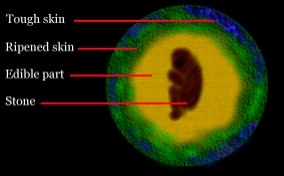When the awatkrano starts rotting, its skin turns red. Half rotten awatkrano is a delicatessen in Fanigawi, but the pirates of Roverseiland won’t eat it.
The sweet flesh of the awatkrano is very healthy and has helped many sailor out of the sickbed. It is also sold in small doses on the markets of Daleth as an aphrodisiac and a common medicine.
Under natural circumstances, after the awatkrano is rotten away the stone sinks back into the sea where it grows a new awatkrano. The stone has roughly the shape of a human fetus.
On Roverseiland, the children are told the babies are born from the awatkrano, and their mothers pick them up during their fishing expeditions. Finding a awatkrano-stone on the shore is a bad sign, usually understood as the death of a child. This superstition is also known from the shores of De Weslanan.
In Fanigawi, finding such a stone is seen as a sign of luck (most of the time). The finder will have a large family. The stones are sold as amulets in Fanigawi and it is known that in the distance city of Abitsu, Luban there is a large number of awatkrana-stones in the private collection of the local siwagat, who probably bought them from Fanigawan traders. The locals of Abitsu believe they are the sun-dried, unborn children of women who went out in the desert too long and died there - the children have been taken out of the womb by dahiník.

Related topics: